Usually when our family has gone to the Maple Syrup festivals in the spring we want to cuddle up next to the warm fires where the syrup is boiling. Not so much today.
Today, the campfire evoked thoughts of hot dogs, s'mores, and swimming holes, and we could use the smoke to keep the mosquitoes away instead of warming ourselves.
Hard to believe it was almost 80 degrees! I suppose this unseasonable warm weather is going to make Maple Syrup expensive since it cut the sap collecting season short.
 |
| So many families here today! |
 |
| I have always loved red twig dogwood |
Tree Anatomy
Lynette first taught everyone about tree anatomy using a nifty felt tree with felt "flappy" layers that peeled back to reveal each layer.
 |
| Learning about tree anatomy from Lynette using the felt tree |
We learned about the trees layers starting from the outside: Bark, cambium, xylem, phloem, heartwood.
The tree rings are formed from the cambium when the xylem dies each year.
Learn more about how tree rings are formed at Real Trees 4 Kids.
 |
| Diagram from Tree Boss |
"While the center of the trunk is usually "just wood" (Heartwood), the inner bark consists of living tissue. These layers are known as the Phloem and the Cambium, with the cambium being the growth layer....
"The xylem transports water and nutrients up the tree, and phloem transports products of photosynthesis back down." -- Tree Boss
How Sap Flows
We learned that the sap would freeze during the winter and make the tree "explode". So the tree sends all its sap to the roots during the winter.
When the weather warms up during the day the sap rises and then goes back down to the roots when the temperatures go below freezing at night.
Sap, the tree's nutrients, move up and down the tree in a loop during this cycle of warm and cold periods.
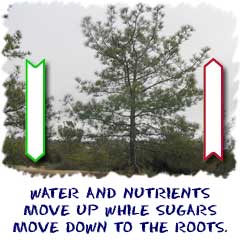 |
| Biology 4 Kids |
Learn more about how sap flows from the Cornell Sugar Maple Research & Extension Program.
Learn more about the vascular system of trees at Biology 4 Kids .
Interesting finds in the woods
Mourning Cloak Butterfly
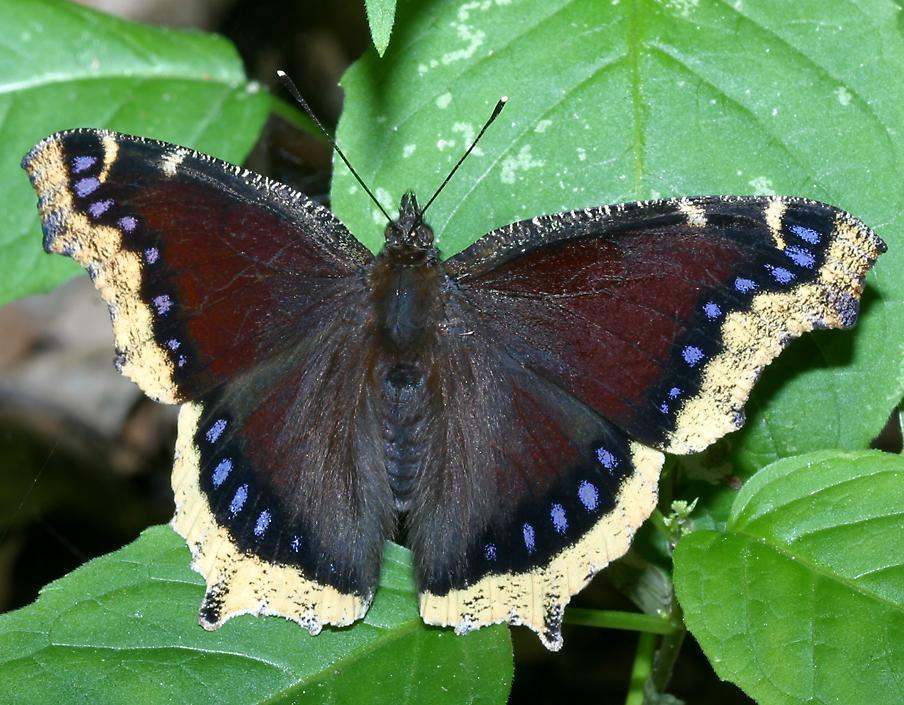 |
| Mourning Cloak Butterfly from Flying Kiwi (lots of beautiful butterfly pictures on that website!) |
"Mourning cloak butterflies are very hairy, they're one of the very few butterflies which actually live right through the incredibly cold and snowy Illinois winters, which means that they're often the first butterflies that people see in spring. Since there are no flowers for them to gather nectar at in early springtime, they depend on sap flowing from branches and twigs broken by the wind." - Flying Kiwi
Learn even more about them at Butterflies and Moths of North America and discover what kind of sap they like the best.
If you are getting ready to plant flowers in your garden you can find out what kinds of plants will attract butterflies in Michigan at Michigan Gardener.
Michigan Brown Snake
 |
| Surprise! A Michigan Brown Snake |
Next we saw a Michigan Brown Snake slithering through the leaves on the forest floor.
Visit the Michigan Society of Herpetologists learn more about these interesting snakes.
Are they just brown?
In what part of the world are are they found?
Where do they like to live?
What do they eat?
Why do you find them in parks?
Would you want them in your garden?
Ancient Rock
Lynette pointed out this big rock. She said it got here because it was left here by glaciers that were here a long time ago.
These "left-over rocks" have a special name. Learn more about the history of glaciers in glaciers in Michigan. Read about why Michigan is shaped like a mitten because of glaciers.
You can do experiments to make your own glacier with ice or GAK (video presentation and instructions.)
 Lynette told us the glaciers used to cover this area and that the glaciers were as tall as the trees in these woods!
Lynette told us the glaciers used to cover this area and that the glaciers were as tall as the trees in these woods!
Forest History
 Lynette pointed out that the forest has lots of adult trees that are the same size so you can tell they were planted at the same time. Then she pointed out all the baby trees that are the same size so they are the same age.
Lynette pointed out that the forest has lots of adult trees that are the same size so you can tell they were planted at the same time. Then she pointed out all the baby trees that are the same size so they are the same age.
When the adult trees die the baby trees will grow up and take their place.
She said there will probably be about 20 years when the small trees won't be big enough to replace the older trees for collecting sap.
Chickadee
Okay, this one we didn't see but we heard it!
Lynette said you can it was a Chickadee because of it's song "teacher, teacher."
Listen to the sound of this Chickadee at The Cornell Lab of Ornithology and hear what we heard. We heard the sound listed under the "typical song."
We saw a woodpecker fly up high into a tree. I initially thought it was a Blue Jay. I can't remember what kind Lynette told us it was and I didn't have it my "field notes" (aka the scribble book for when kids are bored).
 One of the kids saw a standing tree all hollowed out and wondered why it looked that way. Lynette talked about how trees eventually die and the decomposers break down the trees.
One of the kids saw a standing tree all hollowed out and wondered why it looked that way. Lynette talked about how trees eventually die and the decomposers break down the trees.
Pine Trees
We learned pine trees are conifers because they are evergreen and don't lose their needles/leaved in the winter. Pine tree sap doesn't freeze in the winter so the tree can provide nutrients for the needles all year long.
We also learned how to tell the difference between white pine and red pine trees. They can be identified by looking at their needles and counting the number in each cluster.
White pine clusters have 5 needles. Just like "white" has 5 letters.
Red pine clusters have 2 needles which is just 1 letter less than "red."
Maple Leaves
Lynette showed us some of the dried up maple leaves and how to identify them. Maple leaves have 3 lobes and and the veins all meet down at the bottom.
How Sap is Collected and Processed
 We first learned about how Native Americans collected and used sap. A branch was cut and carved to use as a spile to tap into the tree. A Birch basket was used to collect the sap. We learned Birch bark is waterproof.
We first learned about how Native Americans collected and used sap. A branch was cut and carved to use as a spile to tap into the tree. A Birch basket was used to collect the sap. We learned Birch bark is waterproof.
 "These gorgeous containers are the work of Jarrod Stone Dahl, they are a traditional basket design made by native Americans around the great lakes." -- Robin Wood
"These gorgeous containers are the work of Jarrod Stone Dahl, they are a traditional basket design made by native Americans around the great lakes." -- Robin Wood
You might want to try to make your own basket, even using alternative materials, following the steps at North house Folk School or Nature Skills.
I found this picture on the internet. It is a spile hand made by a home school student during a workshop! It looks similar to the one Lynette showed us today.
 After collecting the sap it was transferred to a big hollowed out log. Rocks were heated over a fire and then placed into the log with the sap to boil down the sap. They made the sap into sugar because that was easier to transport than syrup.
European Settlers/Pioneers
After collecting the sap it was transferred to a big hollowed out log. Rocks were heated over a fire and then placed into the log with the sap to boil down the sap. They made the sap into sugar because that was easier to transport than syrup.
European Settlers/Pioneers
 The pioneers learned about maple syrup from the Native Americans but did things a little differently.
The pioneers learned about maple syrup from the Native Americans but did things a little differently.
The settlers used metal kettles suspended over a fire to boil down their sap.
The metal kettles made the syrup taste like metal. So we don't use those anymore.

The settlers would have used wooden yokes to carry buckets of sap from the trees to the kettle.
One way of boiling the sap today is to put the syrup in these evaporator bins over a heated fire which is similar what the settlers did. We also observed the evaporator and noticed there was both smoke and steam. We talked about how steam is made of particles of water and smoke is made of pieces of wood.
This method is even easier. Instead of using buckets on the trees to collect the sap and then delivering sap to the evaporators, this method uses tubes connected from the trees directly to the evaporator.
Tapping Trees.
 Lynette showed us this cross section of a tree that had been tapped to collect sap. We counted 7 or 8 indents in the tree where a spile had been inserted. She told us how the tree heals after it has been tapped.
Lynette showed us this cross section of a tree that had been tapped to collect sap. We counted 7 or 8 indents in the tree where a spile had been inserted. She told us how the tree heals after it has been tapped.
A tree has to be at least 12" in diameter to be old enough to tap. Once they are that size they have enough extra sap to share without it hurting the tree.
This is how many taps you can put into a tree depending on its diameter.
12" - 1 spiles
18" - 2 spiles
24" - 3 spiles
Lynette showed us the molds that settlers used for maple sugar. They would mold the sugar into these shapes and gift them as gifts.
The sap has about a 6% sugar content. So it takes 45 gallons of sap to make 1 gallon of syrup. Lynette said you could probably make about a pint of maple syrup from one tree at home.
The first thing we had to do was measure the diameter of the tree to make sure it was at least 12"
 Next we had to look for a spot to drill. Lynette said you need to make sure to not drill into a hole that was there before.
Next we had to look for a spot to drill. Lynette said you need to make sure to not drill into a hole that was there before.
Drilling.....
And drilling...
We hammered in the spile...
But still no sap!
It was almost 80 degrees. So you can tell the temperatures have not been dipping below freezing at night.
It's been much too warm at night. Notice we don't have coats on and are in short sleeves and shorts.
This is what we SHOULD be wearing this time of year and the sap might still be flowing!

This means the sap collecting season was very short and there won't be nearly as much maple syrup being made this year.
We learned you can tap many different trees and get syrup. Any maple tree will do, not just sugar maples.
Box elders also work because they are part of the maple family. You can also tap birch trees.
The tastes and sugar content will vary.
Instructions and supplies for tapping your own trees can be found at Tap My Trees.
 eeks! Lynette spotted some garlic mustard in a spot where they had tried to eradicate it last year. It's an invasive species that came from somewhere else and doesn't belong here. It has no natural predators (except humans who can eat it) so it grows and crowds out other things.
eeks! Lynette spotted some garlic mustard in a spot where they had tried to eradicate it last year. It's an invasive species that came from somewhere else and doesn't belong here. It has no natural predators (except humans who can eat it) so it grows and crowds out other things.
It smells like onion (but not garlic or mustard...go figure!)
Garlic mustard can be used in recipes. Lynette said it is great in pesto.
Turtles
We saw one big and one small painted turtle on the log. Lynette identified them for us based in their red edges.
Ancient Rock
Lynette pointed out this big rock. She said it got here because it was left here by glaciers that were here a long time ago.
These "left-over rocks" have a special name. Learn more about the history of glaciers in glaciers in Michigan. Read about why Michigan is shaped like a mitten because of glaciers.
You can do experiments to make your own glacier with ice or GAK (video presentation and instructions.)
 Lynette told us the glaciers used to cover this area and that the glaciers were as tall as the trees in these woods!
Lynette told us the glaciers used to cover this area and that the glaciers were as tall as the trees in these woods!Forest History
 Lynette pointed out that the forest has lots of adult trees that are the same size so you can tell they were planted at the same time. Then she pointed out all the baby trees that are the same size so they are the same age.
Lynette pointed out that the forest has lots of adult trees that are the same size so you can tell they were planted at the same time. Then she pointed out all the baby trees that are the same size so they are the same age. When the adult trees die the baby trees will grow up and take their place.
She said there will probably be about 20 years when the small trees won't be big enough to replace the older trees for collecting sap.
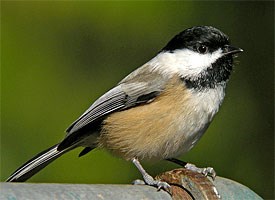 |
| Black Capped Chickadee from The Cornell Lab of Ornithology |
Lynette said you can it was a Chickadee because of it's song "teacher, teacher."
Listen to the sound of this Chickadee at The Cornell Lab of Ornithology and hear what we heard. We heard the sound listed under the "typical song."
Woodpecker
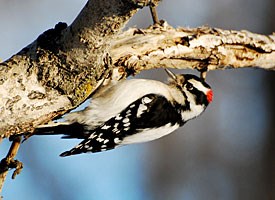 |
| Downey Woodpecker from The Cornell Lab of Ornithology |
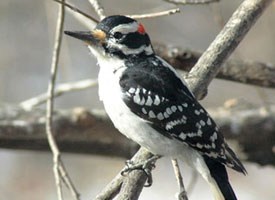 |
| Hairy Woodpecker from The Cornell Lab of Ornithology |
We saw a woodpecker fly up high into a tree. I initially thought it was a Blue Jay. I can't remember what kind Lynette told us it was and I didn't have it my "field notes" (aka the scribble book for when kids are bored).
I recall Lynette said it was similar to another kind of woodpecker but you could tell them apart by the size of the the bill. The one we saw had a small bill. The other one has a bill that is longer than it's head.
I'm guessing what we saw was a Downey Woodpecker which is similar to a Hairy Woodpecker. (Click the links to learn more about them and listen to their sounds.
Hollow Logs
 One of the kids saw a standing tree all hollowed out and wondered why it looked that way. Lynette talked about how trees eventually die and the decomposers break down the trees.
One of the kids saw a standing tree all hollowed out and wondered why it looked that way. Lynette talked about how trees eventually die and the decomposers break down the trees.Pine Trees
We learned pine trees are conifers because they are evergreen and don't lose their needles/leaved in the winter. Pine tree sap doesn't freeze in the winter so the tree can provide nutrients for the needles all year long.
We also learned how to tell the difference between white pine and red pine trees. They can be identified by looking at their needles and counting the number in each cluster.
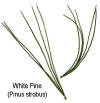 |
| Source |
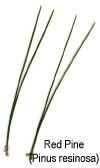 |
| Source |
Red pine clusters have 2 needles which is just 1 letter less than "red."
Maple Leaves
 |
| Source |
And finally we arrived at site for the sap collection and processing! I must say, it was probably somewhat anticlimactic after all the fun adventures on the way there! And we've seen most of this demonstration a few times at past festivals.
Native Americans
 We first learned about how Native Americans collected and used sap. A branch was cut and carved to use as a spile to tap into the tree. A Birch basket was used to collect the sap. We learned Birch bark is waterproof.
We first learned about how Native Americans collected and used sap. A branch was cut and carved to use as a spile to tap into the tree. A Birch basket was used to collect the sap. We learned Birch bark is waterproof. "These gorgeous containers are the work of Jarrod Stone Dahl, they are a traditional basket design made by native Americans around the great lakes." -- Robin Wood
"These gorgeous containers are the work of Jarrod Stone Dahl, they are a traditional basket design made by native Americans around the great lakes." -- Robin Wood |
| Source |
You might want to try to make your own basket, even using alternative materials, following the steps at North house Folk School or Nature Skills.
 |
| Hand made wooden spile from Along the Crooked Path |
 After collecting the sap it was transferred to a big hollowed out log. Rocks were heated over a fire and then placed into the log with the sap to boil down the sap. They made the sap into sugar because that was easier to transport than syrup.
After collecting the sap it was transferred to a big hollowed out log. Rocks were heated over a fire and then placed into the log with the sap to boil down the sap. They made the sap into sugar because that was easier to transport than syrup. The pioneers learned about maple syrup from the Native Americans but did things a little differently.
The pioneers learned about maple syrup from the Native Americans but did things a little differently. The settlers used metal kettles suspended over a fire to boil down their sap.
The metal kettles made the syrup taste like metal. So we don't use those anymore.

How we do it today
 |
| Steam vs. Smoke |
 |
| No sap buckets needed here |
Tapping Trees.
 Lynette showed us this cross section of a tree that had been tapped to collect sap. We counted 7 or 8 indents in the tree where a spile had been inserted. She told us how the tree heals after it has been tapped.
Lynette showed us this cross section of a tree that had been tapped to collect sap. We counted 7 or 8 indents in the tree where a spile had been inserted. She told us how the tree heals after it has been tapped.A tree has to be at least 12" in diameter to be old enough to tap. Once they are that size they have enough extra sap to share without it hurting the tree.
This is how many taps you can put into a tree depending on its diameter.
12" - 1 spiles
18" - 2 spiles
24" - 3 spiles
Lynette showed us the molds that settlers used for maple sugar. They would mold the sugar into these shapes and gift them as gifts.
 |
| Source |
The first thing we had to do was measure the diameter of the tree to make sure it was at least 12"
 |
| Source: US Tape |
We used a special measuring tape that shows the diameter of the tree when you measure the circumference.
We decided it was a "pi" tape! And pi day was this week.
 Next we had to look for a spot to drill. Lynette said you need to make sure to not drill into a hole that was there before.
Next we had to look for a spot to drill. Lynette said you need to make sure to not drill into a hole that was there before.
There would be scar tissue at the site of an old hole and you wouldn't be able to get sap from that spot.
Drilling.....
And drilling...
We hammered in the spile...
But still no sap!
It was almost 80 degrees. So you can tell the temperatures have not been dipping below freezing at night.
It's been much too warm at night. Notice we don't have coats on and are in short sleeves and shorts.
 |
| Source |
This is what we SHOULD be wearing this time of year and the sap might still be flowing!

This means the sap collecting season was very short and there won't be nearly as much maple syrup being made this year.
The lids on the buckets help to keep out rain and ants who love the sweet sap.
 |
| Learn how to tap at home from the Art of Doing Stuff |
We learned you can tap many different trees and get syrup. Any maple tree will do, not just sugar maples.
Box elders also work because they are part of the maple family. You can also tap birch trees.
The tastes and sugar content will vary.
Instructions and supplies for tapping your own trees can be found at Tap My Trees.
Heading Back
It's a great day for a walk on the trail.
Garlic Mustard
 eeks! Lynette spotted some garlic mustard in a spot where they had tried to eradicate it last year. It's an invasive species that came from somewhere else and doesn't belong here. It has no natural predators (except humans who can eat it) so it grows and crowds out other things.
eeks! Lynette spotted some garlic mustard in a spot where they had tried to eradicate it last year. It's an invasive species that came from somewhere else and doesn't belong here. It has no natural predators (except humans who can eat it) so it grows and crowds out other things. |
|
|
Lynette passed around some pieces to smell.
It smells like onion (but not garlic or mustard...go figure!)
Garlic mustard can be used in recipes. Lynette said it is great in pesto.
Turtles
We saw one big and one small painted turtle on the log. Lynette identified them for us based in their red edges.
Tadpoles
Minnows
Whatever this tree with berries is
 I have no idea what this is but I thought it was so pretty.
I have no idea what this is but I thought it was so pretty.Turtles and Bird Nests on display inside


Getting ready for the gift shop
 And a very exciting end to the tour...using math and money knowledge to go shopping in the gift shop full of bugs, animals, and jewelry all on a kids' budget. Sweet!
And a very exciting end to the tour...using math and money knowledge to go shopping in the gift shop full of bugs, animals, and jewelry all on a kids' budget. Sweet!





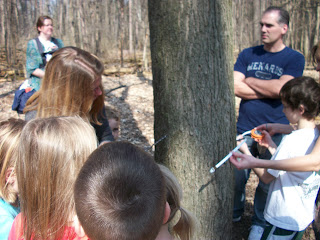












0 comments:
Post a Comment